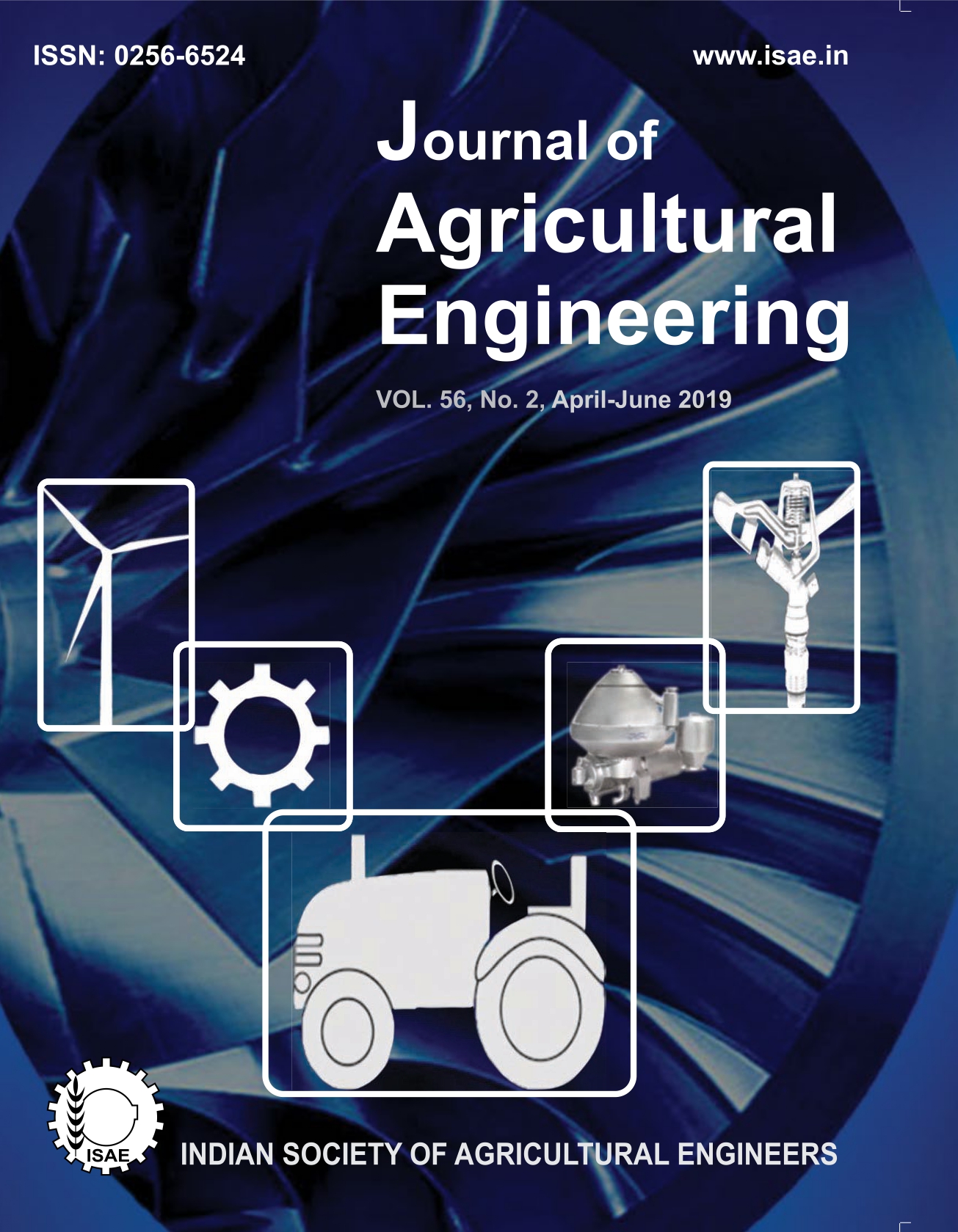Optimization of Oil Loading and Starch-Protein Ratio for Encapsulation of Flaxseed Oil Using Response Surface Methodology
DOI:
https://doi.org/10.52151/jae2019562.1680Keywords:
Flaxseed oil, alpha linoleic acid, encapsulation efficiency, whey protein isolate, response surface methodologyAbstract
Microencapsulation of flaxseed oil (FSO) was studied with tapioca starch (TS)-whey protein isolate (WPI) combination as a shell material using spray drying to optimize the process variables for preparation of spray dried microcapsules of flaxseed oil using TS-WPI coating material combination. Box Behnken design (3k ) was used to design the experimental runs of selected independent variables (three level), which included starch: protein ratio (1:1, 3:1 and 5:1) and oil loading (20 %, 25 %, and 30 %) of total solids in feed mixture and inlet air temperature (IAT:160 o C, 170 o C, and 180 o C) of spray dryer. Response surface methodology (RSM) was used for response analysis and for optimization of process variables for maximizing encapsulation efficiency and minimizing peroxide value (PV). Quadratic models were significantly fitted to the responses with high coefficient of determination (R2 ). The optimum conditions predicted based on numerical optimization were 20 % oil loading, 2.40:1 TS: WPI ratio and 170 o C drying air temperature, respectively. The results of responses observed after confirmatory experiment were in good agreement with the predicted responses of the model.
References
AOAC. 2000. Official Methods of Analysis. 17th edition, The Association of Official Analytical Chemists, Gaithersburg, MD, USA, Method 934.06, Chapter 37, 4.
AOCS. 2000. Determination of Oil Content in Oilseeds. American Oil Chemists’ Society. Urbana, IL, 2-93.
Bae E K; Lee S J. 2008. Microencapsulation of avocado oil by spray drying using whey protein and maltodextrin. J. Microencapsulation, 25, 549-560.
Benichou A; Aserin A; Garti N. 2002. Protein-polysaccharide interactions for stabilization of food emulsions. J. Dispersion Sci. Technol., 23, 93-123.
Bibwe B; Indra Mani; Kar A; Datta A. 2017. Optimization of jackfruit seed starch-soya protein isolate ratio and process variables for flaxseed oil encapsulation. Ind. J. Agric. Sci., 87 (12), 1657-1663.
Bylaite E; Venskutonis P R; Mapdpieriene R. 2001. Properties of Caraway (Carumcarvi L.) essential oil encapsulated into milk protein based matrices. Eur. Food Res. Technol., 212(6), 661-670.
Carneiro H C F; Tonon R V; Carlos R; Grosso F; Hubinger M D. 2013. Encapsulation efficiency and oxidative stability of flaxseed oil microencapsulated by spray drying using different combinations of wall materials. J. Food Eng., 115, 443-451.
Carraro J C C; Dantas M; Espeschit A C R; Martino H S D; Ribeiro S M R. 2012. Flaxseed and human health: Reviewing benefits and adverse effects. Food Rev. Int., 28(2), 203-230.
Charve J; Reineccius G A. 2009. Encapsulation performance of proteins and traditional materials for spray dried flavours. J. Agric. Food Chem., 57, 2486- 2492.
Chobert J M; Gaudin J C; Dalgalarrondo M; Haertle T. 2006. Impact of maillard type glycation on properties of blactoglobulin. Biotechnol. Adv., 24, 629-632.
Desai K G H; Park H J. 2005. Recent developments in microencapsulation of food ingredients. Drying Technol., 23, 1361-1394.
Drusch S; Serfert Y; Scampchio M; Schmidt H B; Schwarz K. 2007. Impact of physic-chemical characteristics on the oxidative stability of fish oil microencapsulated by spray drying. J. Agric. Food Chem., 55(26), 11044-11051.
Hari B V; Praneetha T; Prathyusha T; Mounika K; Devi D R. 2012. Development of starch-gelatin complex microspheres as sustained release delivery system. J. Adv. Pharm. Technol. Res., 3, 182-187.
Jafari S M; Assadpoor E; Bhandari B; He Y. 2008. Nano-particle encapsulation of fish oil by spray drying. Food Res. Int., 41,172–183.
Jimenez M; Garcia H S; Beristain C I. 2004. Spray-drying microencapsulation and oxidative stability of conjugated linoleic acid. Eur. Food Res. Technol., 219, 588-592.
Kapusniak J; Toma s ik P. 2 0 0 6 . L i p i d microencapsulation in starch. J. Microencapsulation, 23, 341-348.
Monica O E; Herrera A. 2014. Use of starch and milk proteins in microencapsulation. Int. J. Veg. Sci., 20(4), 289-304.
Loksuwan J. 2007. Characteristics of microencapsulated β-carotene formed by spray drying with modified tapioca starch, native tapioca starch and maltodextrin. Food Hydrocolloids, 21, 928-935.
Narsaiah K; Wilson R A; Gokul K; Mandge H M; Jha S N; Bhadwal S; Rahul K A; Mallik R; Vij S. 2015. Effect of Bacteriocin-incorporated alginate coating on shelf life of minimally processed papaya (Carica papaya L.). Postharvest Biol. Technol., 100, 212-218.
Omar K A; Liang S; Zou X; Zhihua S; Wang X. 2009. Effect of two emulsifiers on yield and storage of flaxseed oil powder by response surface methodology. Pak. J. Nutr., 8(9), 1316-1324.
Pedro R B; Tonon R V; Hubinger M D. 2011. Effect of oil concentration on the microencapsulation of flaxseed oil by spray drying. Agrobio. Envases, 27-28 September, Campinas, Bazil, 1-5.
Polavarapu S; Oliver C M; Ajlouni S; Augustin M A. 2011. Physicochemical characterization and oxidative stability of fish oil and fish oil–extra virgin olive oil microencapsulated by sugar beet pectin. Food Chem.,127(4),1694-1705.
Quispe-condori S; Saldana M D A; Temelli T. 2011. Microencapsulation of flax oil with zein using spray and freeze drying. LWT - Food Sci. Technol., 44, 1880-1887.
Rodea-González D A; Cruz-Olivares J; Román- Guerrero A; Rodríguez-Huezo M; Vernon-Carter E J; Pérez-Alonso C. 2012. Spray-dried encapsulation of chia essential oil (Salvia hispanica L.) in whey protein concentrate-polysaccharide matrices. J. Food Eng., 111,102-109.
Rodriguez-Leyva D; Bassett C M C; McCullough R; Pierce G N. 2010. The cardiovascular effects of flaxseed and its omega-3 fatty acid, alpha-linolenic acid. Can. J. Cardiol., 26(9), 489-496.
Shantha N C; Decker E A. 1994. Rapid, sensitive, iron-based spectrophotometric methods for determination of peroxide value of food lipid. J. AOAC Int., 77(2), 421-424.
Sheu T Y; Rosenberge M. 1995. Microencapsulation by spray drying ethyl caprylate in whey protein andv














